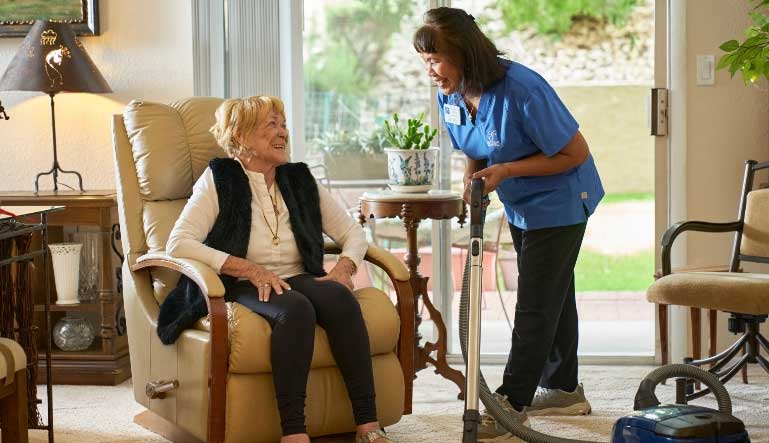A big source of pride for many folks is being able to take care of themselves without assistance. Whether it’s home upkeep, managing medications or personal hygiene, being able to do these tasks independently can be very fulfilling. Yet, as we age and our bodies aren’t able to function like they used to, many of these once routine tasks can become more and more challenging. Knowing when additional help is required—and how much of it you need—can also be difficult. That’s where Activities of Daily Living (ADLs) and Instrumental Activities of Daily Living (IADLs) come in.
ADLs and IADLs are both services offered by senior living communities that help residents—particularly those in assisted living—stay independent for longer. Though they have nearly identical names, ADLs and IADLs have key differences in the services they include that together form a holistic level of care. Here’s what you should know about both terms so you can determine how much extra care you or your loved one needs to maintain independence.
What are Activities of Daily Living, or ADLs?
Activities of Daily Living (ADLs) are routine tasks most people are able to perform on a daily basis without assistance. Most senior living providers and health professionals group ADLs into the following categories:
Common Categories of Activities of Daily Living (ADLs) |
|
|
Dressing |
Being able to dress and undress, choose appropriate clothing for the weather and have the dexterity to manage buttons, zippers and other fasteners. |
|
Eating |
The ability to feed oneself (not including cooking). |
|
Bathing or Showering |
This includes grooming activities such as shaving and brushing teeth and hair. |
|
Continence |
Being able to control bowels and bladder or to manage incontinence independently. |
|
Toileting |
The ability to use the toilet and get to the toilet independently. |
|
Transferring |
This refers to functional mobility. For most people, functional mobility is being able to walk, get in and out of bed, and into and out of a chair. If the person is not ambulatory, they should be able to transfer from bed to wheelchair on their own. |
What are Instrumental Activities of Daily Living, or IADLs, and how are IADLs different from ADLs?
Instrumental Activities of Daily Living (IADLs) are more complex tasks that often build on basic ADLs, but require a certain amount of physical dexterity, sound judgment and organizational skills. IADLs are not essential functions of living like ADLs, though they are key to being able to live independently. Instrumental activities of daily living typically include the following:
Common Instrumental Activities of Daily Living (IADLs) |
|
|
Managing finances |
Paying bills and managing financial assets. |
|
Managing transportation |
Either by driving, using public transportation or by organizing other means of transport. |
|
Shopping and meal preparation |
Grocery shopping, cooking and any other activity required to prepare your own meals. |
|
Housecleaning and home maintenance |
Keeping one’s living space reasonably clean and tidy and overall maintaining of the home. |
|
Managing communication |
Using the telephone and managing mail. |
|
Managing medications |
Obtaining medications and taking them as directed. |
How do I know if and which ADLs and IADLs are needed?
The signs that it’s time to consider help with ADLs and IADLs can take a while to appear and be difficult to spot. It’s common to need a little more assistance with our day-to-day as we get older and we’re not as spry as we used to be. That’s why one of the best ways to evaluate the need for ADLs and IADLs is through a functional assessment performed by a doctor, rehabilitation provider or senior living specialist.
Difficulty managing instrumental activities of daily living is often an early indicator of other health problems. This assessment can help seniors determine what kind of assistance is needed on a day-to-day basis. An inability to perform two or three activities in a functional assessment is often a sign that one would benefit from outside help, or by considering moving to an assisted living community where ADL and IADL services are available.
Five Star Care: All the services you need, when you need them
In our Five Star Senior Living communities, no two residents are alike, so we personalize our level of care to fit your needs. That includes any help with ADLs and/or IADLs that you or your loved one needs to embrace and enjoy their best life and live stress-free. Call one of our senior care experts at (757) 797-6866 or complete the form below to find a Five Star community near you.
Contact Us Today
"*" indicates required fields

